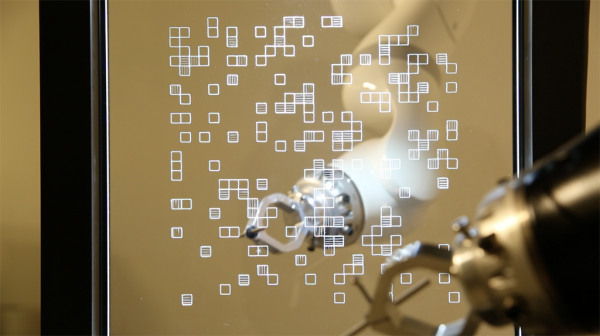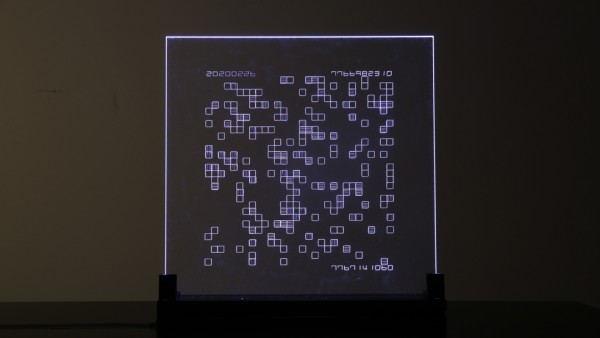Log, teamVOID, 2020
“Log” is a robotic performance that records real-time population data on transparent acrylic plate, asking questions about the meaning of birth and death in a massive human-made system and the behavior of recording them.
The work began with the daily death toll of COVID-19 (a.k.a Coronavirus) which is spreading worldwide from late 2019. The COVID-19 has been causing mass fatalities and we are beginning the day by looking at the death toll updated in every day. The number of deaths has been left an indicator of the virus’ influence, diluting the real meaning of death in our life. This experience led us to ask questions about the gap between population data seen in numbers and actual birth and death, and whether a system recording physically all births and deaths can reduce this gab.
Based on above questions, real-time births and deaths data were identified from the population change prediction website (www.worldometer.info). Every second, about 4-5 people were born and 1-2 people died. Two robotic arms were used to record this data. The white robot at the top takes birth data and the black one at the bottom records death data by engraving, the most primitive way of recording by human, a simple geometric pattern on both sides of the acrylic plate every 250 births and deaths. Industrial robot is the symbol of human labor substitutes and their performance physically visualize modern data recording system. In other words, it is conceptually same as the function of modern digital servers transformed into a physical form. The work completes one image throughout the day, and the date and population number of beginning and end of performance marked on the plate to ensure the uniqueness of the record. The background sound, reacting to birth and death data, occurs during a performance to audiolize transition between them.
“Log” physically reveals the existence of modern data systems digitizing every data. It is reflecting the systemic society that the most human-relevant data, births and deaths, also being recorded by machines.





로그는 실시간 출생/사망 데이터에 반응하여 투명 아크릴 패널에 기록하는 로봇 퍼포먼스 작업으로, 인간이 만든 거대한 시스템안에서 출생과 죽음이 갖는 의미와 그것을 기록하는 행위에 대하여 질문한다.
이 작업은 바이러스 - 코로나19에 의해 매일 보도되는 사망자 숫자에서 시작되었다. 2019년 말 시작되어 전세계적으로 영향을 미치고 있는 코로나19 바이러스는 매일 대량의 사망자를 발생시키고, 우리는 매 순간 업데이트되는 사망자 숫자를 보며 하루를 시작하고 마무리하고 있다. 하지만 어느 순간 사망자의 숫자는 죽음이라는 개념을 희석시키고 바이러스의 영향력을 보여주는 지표로 남게 되었다. 이러한 경험은 작가로 하여금 오늘날 숫자로 보여지는 인구변화와 실질적인 출생과 죽음 사이에 어떤 차이를 만들어 내는지, 그리고 하루의 모든 출생과 죽음의 물리적인 기록을 통해 그 괴리감을 줄일 수 있는지에 대해 질문하게 했다.
두 질문을 바탕으로 인구변화 예측 사이트worldometer(worldometers.info) 의 데이터로부터 실시간 출생자수와 사망자 수를 확인하였고, 1초에 약 4~5명의 사람이 태어나고, 1~2명이 죽고 있음을 확인하였다. 이 데이터를 기반으로 그것을 기록하는 행위는 2대의 산업용 로봇암이 아크릴 판위에 각인 하는 방식으로 진행되며, 상단의 흰색 로봇은 출생을, 하단의 흑색 로봇은 죽음을 데이터의 단위 수량(1 draw per 250 people)에 맞추어 단순하고 기하학적인 패턴으로 아크릴판의 양쪽 면에 기록하게 된다. 산업용 로봇은 인간의 노동 대체 장치의 상징으로서, 로봇 퍼포먼스는 시스템화된 현대의 기록 과정을 물리적으로 시각화 하고있다. 다시말해, 현대의 디지털 서버의 기능과 같은 형태이지만 물리적인 형태로 변형된 모습이라고 할 수 있다. 작업은 하루동안 한 장의 그림을 완성하며, 날짜와 시작/종료 인구를 숫자로 표시함으로써 기록의 유일성을 확보한다. 퍼포먼스중 발생하는 배경 사운드는 출생과 사망자 데이터의 변화를 청각화한다.
로그는 실시간으로 모든 인간의 출생과 죽음까지도 디지털화 하여 기록하고 있는 현대 데이터 시스템의 존재감을, 인간의 가장 원시적인 기록 방식인 각인을 통해 로봇암이 기록하는 과정을 물리적으로 보여줌으로써, 가장 인간적인 데이터 또한 기계에 의해 기록되고 있는 시스템화 된 우리 사회의 모습을 반영한다.